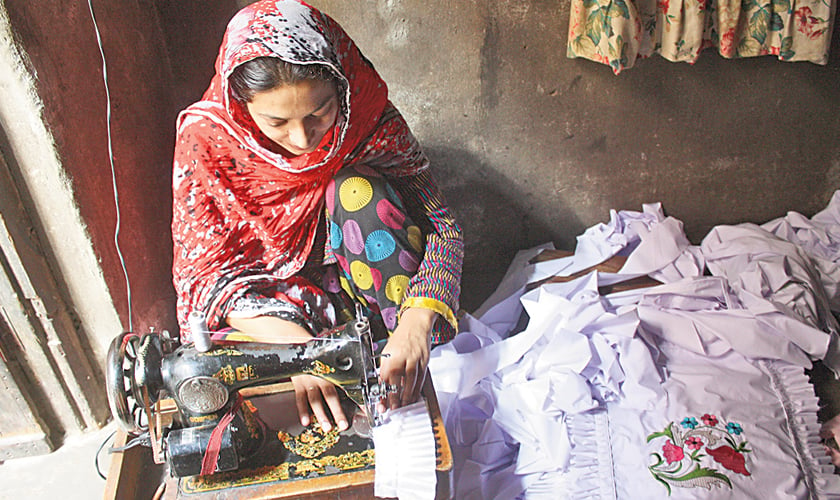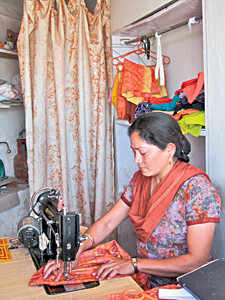This week You! talks to a few home-based women tailors regarding their profession and problems associated with it...
This week You! talks to a few home-based women tailors regarding their profession and problems associated with it...
It is estimated that there are over 100 million home-based workers in the world and more than half this number are in South Asia out of which almost 80 percent are women. Pakistan is one of the Asian countries that has the largest number of women engaged in home-based work and this sector has expanded at a fast pace.
While we talk about different professions carried out in various households, one of the most common professions acquired by women in Pakistan is working as home-based tailors who we generally refer to as darzans. These women tailors face severe problems like lack of professional training, physical mobility, health, safety and limited access to productive resources. 'Home-based tailors' commonly fall in the category of workforce who work within the informal or unorganised sector and carry out a remunerative job within their homes or in the surrounding areas.

These home-based women tailors usually belong to poor or lower-middle class backgrounds, from various age groups, and are usually not highly educated. These women are basically 'self-employed home-based workers' who assume all the risks of being independent operators. They buy their own stitching materials and sewing machines. Most of them do not hire other workers but may seek help from family members.
This week, You! talks to a few home-based women tailors regarding their profession and problems associated with it. Nazia, a resident of Drigh Road area, Karachi, says, "I have been in this line from the last 2 to 3 years. I have six daughters and a household to run for which I had to find a way out. My husband and I always thought about how to make ends meet and which is why we came up with the decision of working collectively to support each other and our family. It was my idea to start tailoring and my husband was supportive of this decision, as with this, I could easily operate from home and also take care of the household."
Nazia didn't learn the skill initially, however, with time she got the hang of it. But now that she has grown up daughters, she often takes their help. Currently, she has sent one of her daughters to a sewing centre to get professional training so that her daughter would bring more creativity to the designs.
When asked on what problems she has to face while completing her orders, Nazia shares, "I can proudly say that in such a short span of time I have become proficient in my work and my clients are really satisfied with the way I stitch. Despite this, I face a lot of hindrances in my work. The regular load shedding has gotten on my nerves. Because of that I often have to use manual sewing machine to complete my orders which consumes a lot of time and energy.
"Secondly what we usually face is the unfair attitude of the customers. They are ready to pay 800-900 rupees to the area's male tailors but if we ask to increase the price, they demean us. They say that those tailors are professionals who are running proper businesses and have their own shops, while we are just darzans who can't charge much since we are sitting at home and we don't have to work on resources (embellishments etc). This upsets me a lot. I work so hard but still I get peanuts. But since I do not have a shop, I have to be patient and I Thank God for at least getting work and earning with dignity," says a content Nazia.
Another female tailor is Maqsooda who hails from Zia Colony, Karachi. She has been in the business from the past 21 years during which she took some break when she got married but continued working after almost a year. "I have always loved stitching!" enthuses Maqsooda. "In the beginning I just used to do cutting. But later on, I thought of acquiring proper training. So, I approached a lady near my house who used to teach the skill to all the girls of our area and got my training done. However, my hobby and passion for stitching became a necessity. My husband works in a sweet shop whose earnings are not enough for all our expenditures," she informs.
Maqsooda shed some light on the hurdles she faces in her profession. "It is very saddening that women are not willing to pay more than 300 rupees for an outfit. They throw tantrums and demand for perfect detailing but they show strong aversion when I demand a justified amount. Also they start comparing our work with male tailors. This is not all. Customers are now more inclined towards buying ready-made garments which has decreased our chances of earning more. Unlike in the past, we are now focusing upon stitching according to latest designs and styles to please our customers
"Last but not least, the electricity breakdown almost costs us a day's meal. It's difficult for us to get the work done if electricity goes out even for a day. We literally work on daily wages so we cannot afford to have any disruption," adds Maqsooda.
Shahida from North Karachi has been stitching clothes from the last 15 years. "The non-availability of raw material is a major problem. If we tell our customers that we ran out of material, they don’t believe us. Also, women behaviour is another issue where clients misbehave and fight with us on petty things. That is why the lady tailors are still struggling to survive in this profession. Many lady tailors have already shifted to other trades and those who are stuck to this line of work are clueless about their future,” concludes Shahida on a disappointing note.